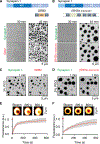A liquid phase of synapsin and lipid vesicles
- PMID: 29976799
- PMCID: PMC6191856
- DOI: 10.1126/science.aat5671
A liquid phase of synapsin and lipid vesicles
Abstract
Neurotransmitter-containing synaptic vesicles (SVs) form tight clusters at synapses. These clusters act as a reservoir from which SVs are drawn for exocytosis during sustained activity. Several components associated with SVs that are likely to help form such clusters have been reported, including synapsin. Here we found that synapsin can form a distinct liquid phase in an aqueous environment. Other scaffolding proteins could coassemble into this condensate but were not necessary for its formation. Importantly, the synapsin phase could capture small lipid vesicles. The synapsin phase rapidly disassembled upon phosphorylation by calcium/calmodulin-dependent protein kinase II, mimicking the dispersion of synapsin 1 that occurs at presynaptic sites upon stimulation. Thus, principles of liquid-liquid phase separation may apply to the clustering of SVs at synapses.
Copyright © 2018, American Association for the Advancement of Science.
Conflict of interest statement
Competing interests:
Authors declare no competing interests.
Figures




Comment in
-
A Presynaptic Liquid Phase Unlocks the Vesicle Cluster.Trends Neurosci. 2018 Nov;41(11):772-774. doi: 10.1016/j.tins.2018.07.009. Epub 2018 Aug 4. Trends Neurosci. 2018. PMID: 30086987
-
Phase changes in neurotransmission.Science. 2018 Aug 10;361(6402):548-549. doi: 10.1126/science.aau5477. Science. 2018. PMID: 30093586 No abstract available.
References
-
- Rizzoli SO, Betz WJ, The structural organization of the readily releasable pool of synaptic vesicles. Science. 303, 2037–2039 (2004). - PubMed
-
- Darcy KJ, Staras K, Collinson LM, Goda Y, Constitutive sharing of recycling synaptic vesicles between presynaptic boutons. Nat. Neurosci 9, 315–321 (2006). - PubMed
-
- Acuna C, Liu X, Südhof TC, How to Make an Active Zone: Unexpected Universal Functional Redundancy between RIMs and RIM-BPs. Neuron. 91, 792–807 (2016). - PubMed
Publication types
MeSH terms
Substances
Grants and funding
LinkOut - more resources
Full Text Sources
Other Literature Sources

